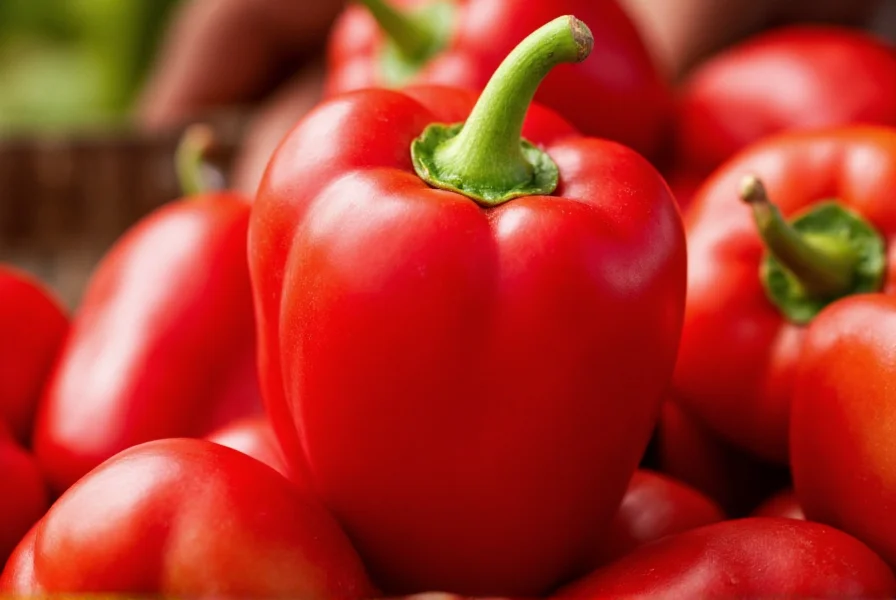Understanding the Complete Nutritional Profile of Red Peppers
Red bell peppers represent the mature version of green bell peppers, having ripened longer on the vine. This extended ripening period significantly enhances their nutritional value compared to their green counterparts. When evaluating the nutritional value of a red pepper, it's essential to understand both the macro and micronutrient composition that makes this vegetable so valuable for health-conscious diets.
According to USDA FoodData Central, a medium red bell pepper (119g) delivers remarkable nutritional density with minimal caloric impact. The vitamin C content in red bell peppers surpasses that of citrus fruits, providing more than triple the amount found in an orange of comparable size. This makes red peppers an exceptional choice for boosting immune system function through natural food sources.
| Nutrient | Amount per Medium Pepper (119g) | Daily Value % |
|---|---|---|
| Calories | 37 | 2% |
| Total Fat | 0.3g | 0% |
| Carbohydrates | 9g | 3% |
| Dietary Fiber | 2.5g | 9% |
| Vitamin C | 152mg | 169% |
| Vitamin A | 157mcg RAE | 93% |
| Vitamin B6 | 0.3mg | 19% |
| Vitamin K1 | 7.4mcg | 6% |
| Potassium | 314mg | 7% |
Key Nutrients and Their Health Implications
The impressive red pepper nutrition facts per 100g reveal why nutritionists consistently recommend incorporating these colorful vegetables into daily meals. Let's examine the most significant nutrients and their health benefits:
Vitamin C Powerhouse
With 190mg of vitamin C per 100g, red bell peppers contain nearly three times more vitamin C than oranges. This potent antioxidant supports immune function, collagen production for skin health, and enhances iron absorption from plant-based foods. The vitamin C content in red bell peppers remains substantial even when cooked, though raw consumption provides maximum benefits.
Vitamin A and Beta-Carotene
Red peppers derive their vibrant color from high concentrations of beta-carotene, which the body converts to vitamin A. This nutrient supports vision health, immune function, and skin integrity. The red pepper vitamin profile for immune system support is particularly robust due to this combination of vitamin A and C.
Antioxidant Diversity
Beyond standard vitamins, red peppers contain unique plant compounds including:
- Capsanthin (responsible for red color)
- Quercetin (anti-inflammatory properties)
- Lutein (supports eye health)
- Violaxanthin (another carotenoid antioxidant)
These compounds work synergistically to reduce oxidative stress and inflammation throughout the body. Understanding the complete nutritional differences between colored bell peppers reveals that red varieties contain up to 9 times more beta-carotene and 1.5 times more vitamin C than green peppers.

Practical Applications: Maximizing Nutritional Benefits
Knowing the health benefits of eating red peppers daily is valuable, but understanding how to incorporate them effectively into your diet matters just as much. Here's how to maximize their nutritional potential:
Optimal Preparation Methods
While red peppers can be enjoyed raw or cooked, certain preparation methods preserve more nutrients:
- Raw consumption preserves maximum vitamin C content
- Light steaming (3-5 minutes) maintains most nutrients while improving carotenoid absorption
- Avoid prolonged boiling which leaches water-soluble vitamins
- Pairing with healthy fats (like olive oil) enhances absorption of fat-soluble vitamins
Dietary Integration Strategies
Consider these practical ways to incorporate red peppers into your meals:
- Add sliced raw peppers to salads for crunch and nutrient density
- Include in stir-fries during the last few minutes of cooking
- Roast peppers to bring out natural sweetness while preserving nutrients
- Blend into sauces and soups for added nutrition without altering flavor significantly
Red Peppers in Nutritional Context
When comparing the red pepper nutrition facts per 100g to other common vegetables, red peppers stand out for their exceptional vitamin density. They contain significantly more vitamin C than broccoli, more beta-carotene than tomatoes, and comparable fiber content to many leafy greens.
For those monitoring carbohydrate intake, red peppers offer a favorable profile with approximately 6g of carbohydrates per 100g, mostly from beneficial fiber and natural sugars. This makes them suitable for various dietary approaches including Mediterranean, DASH, and even moderate low-carb eating patterns.

Storage and Seasonality Considerations
To maintain the impressive nutritional value of a red pepper after purchase:
- Store in the crisper drawer of your refrigerator
- Keep whole peppers unwashed until ready to use
- Use within 1-2 weeks for maximum nutrient retention
- Consider freezing for longer storage (though texture changes)
Peak season for red bell peppers runs from summer through early fall, when they typically offer the highest nutrient density and best flavor. However, modern agricultural practices ensure relatively consistent availability year-round with only modest seasonal variations in nutritional content.
Frequently Asked Questions
How does the nutritional value of red peppers compare to green peppers?
Red peppers contain significantly higher nutrient levels than green peppers due to longer ripening time. They have approximately 11 times more beta-carotene, 1.5 times more vitamin C, and higher concentrations of antioxidants. The extended ripening process converts chlorophyll to carotenoids, enhancing both color and nutritional profile while reducing bitterness.
What's the best way to cook red peppers to retain nutrients?
The best methods for preserving nutrients when cooking red peppers include light steaming for 3-5 minutes, stir-frying at medium heat for minimal time, or roasting. Avoid prolonged boiling as this leaches water-soluble vitamins like vitamin C. Consuming red peppers raw provides maximum vitamin C content, while light cooking can actually improve absorption of certain carotenoids when paired with healthy fats.
Can eating red peppers improve eye health?
Yes, red peppers contain lutein and beta-carotene (which converts to vitamin A), both essential for eye health. Vitamin A supports night vision and overall eye function, while lutein helps protect against age-related macular degeneration. The antioxidant properties in red peppers also combat oxidative stress that can damage eye tissues over time.
Are red peppers suitable for low-carb diets?
Yes, red peppers are relatively low in carbohydrates with approximately 6g of carbs per 100g, of which about 2.5g is fiber. This results in a net carb count of around 3.5g per 100g, making them suitable for moderate low-carb eating patterns. Their high nutrient density provides significant vitamins and minerals without substantially impacting carbohydrate intake.
How many red peppers should I eat daily for optimal health benefits?
While there's no specific recommended daily amount, incorporating one medium red pepper (about 119g) into your daily diet provides substantial nutritional benefits without excessive caloric intake. This amount delivers more than 100% of your daily vitamin C needs and significant amounts of other essential nutrients. Variety remains important, so red peppers should be part of a diverse vegetable intake rather than the sole focus.











 浙公网安备
33010002000092号
浙公网安备
33010002000092号 浙B2-20120091-4
浙B2-20120091-4